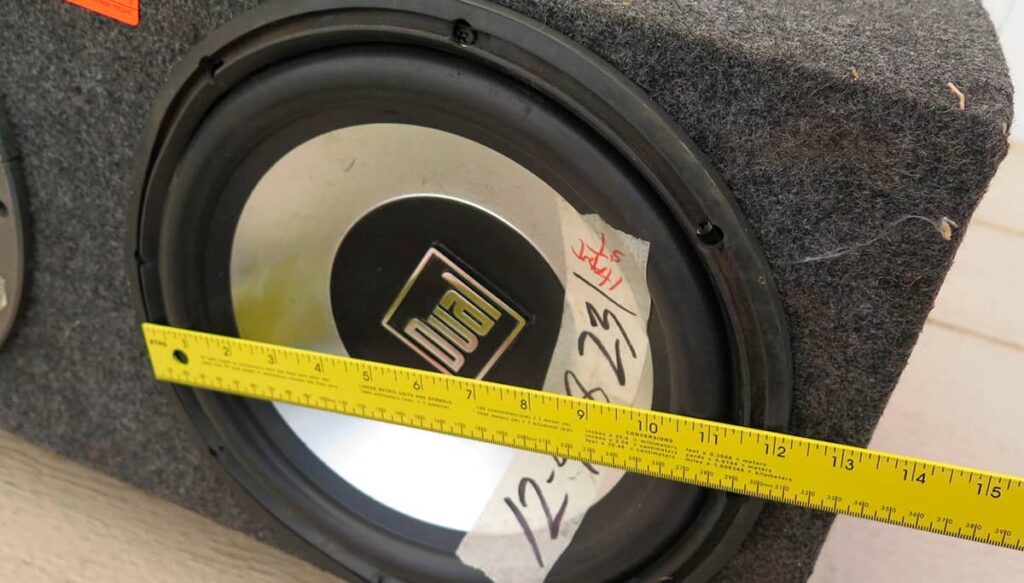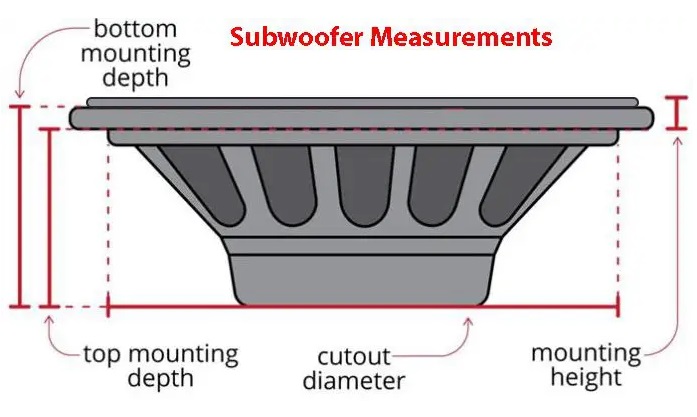About to replace your old or broken subwoofer with the best subwoofer under $300, for example, but want it to fit perfectly in the old enclosure? You will need to take very precise measurements.
However, why can’t you just rely on the information from the manufacturer, given in the user’s manual? Because most of them offer rounded values for the speaker’s size, which aren’t particularly useful when trying to fit the sub in the enclosure. Let’s suppose the diameter of your old speaker is 8.5 inches (as the manufacturer claims). However, if you use a ruler to measure the outside diameter of the object, you could find that it is 8.85 inches.

It’s especially important to ensure that your new speaker is perfectly suitable for your old enclosure if it will be placed in a car trunk. Improper fit may cause unfixable damages to your brand new speaker.
In this guide, we will explain how to measure a subwoofer. We will also inform you about the other considerations that need to be taken into account if you want to place a new subwoofer in the old enclosure. Just don’t forget to take the notes.
What Parts of a Subwoofer Should You Measure?
- Speaker diameter. You may know the diameter of the driver, but you’re unlikely to know the diameter of the whole speaker. To find it out, you will need to measure the subwoofer across the frame.
- Cutout diameter. You may use this measurement to determine the precise size of a mounting hole.
- Mounting height. It will help you make sure that the front part of the sub won’t protrude too much above the enclosure’s top surface. The subwoofer should sit flush in the enclosure.
- Mounting depth. By taking this measurement, you will make sure that the speaker won’t be recessed into the enclosure. It’s also important to know the exact mounting depth to ensure that the sub won’t wobble, fall off, or get stuck in the enclosure.
This picture shows all the measurements that need to be taken.

Step-by-Step Guide
Subwoofer Dimensions
As you can guess, knowing how to measure a subwoofer size will let you find a replacement speaker of exactly the same size, eliminating the possibility that it will not fit in the old box.
Step #1. Detach the subwoofer from the enclosure (don’t forget that it must be turned off beforehand). Usually, this involves nothing more but unscrewing it with the help of a screwdriver. Obviously, you will also need to remove the grilles if the sub has them.
Step #2. Disconnect all the wires so you could pull the sub out.
Step #3. Place the speaker on a perfectly flat surface. For measurement, you can use a ruler or a tape measure. Start measuring from the sub’s back to the frame. This is how you will get the mounting depth.
Step #4. To determine the mounting height, measure the distance from the bottom of the subwoofer to the mounting frame.
Step #5. Turn the sub upside down and measure from one mounting hole to another. This way you will get the cutout diameter. If your subwoofer isn’t round-shaped, you will obviously have to measure each of its sides.
Mounting Holes
This method is less effective than the previous one, but, still, knowing the size of mounting holes, you can choose a sub, suitable for your enclosure. The advantage of this method is the fact that you won’t have to drill new holes.
Step #1. Position your measuring device across the hole, and measure from one end to another (if the hole isn’t of a round shape, measure each of its sides). It should be larger or equal to the baffle cutout diameter on the subwoofer.
Step #2. If the hole has recessed edges, you will need to take two measurements. Measure the actual hole and the cutout diameter from side to side. Make sure that the smaller hole is larger or equal to the baffle cutout diameter. The larger hole should be equal to the overall outside diameter.
Step #3. Next, you should know how to measure a subwoofer box depth. Insert the ruler into the enclosure to find out its depth. Measure the distance from its bottom to the cutout’s edge.
Step #4. Determine the spacing between the screw holes to verify that your new speaker’s screw pattern matches that of the enclosure. The majority of subwoofers feature four mounting screws.
How to Measure the Subwoofer Box Cubic Feet
The air space of your enclosure has some significant impact on the sound. Some subwoofers sound better in larger boxes, while others need smaller ones to create deeper bass. So, to calculate the cubic feet of your enclosure, multiply its height, width, and length. The figure you’ll obtain is the box’s overall volume. Divide this number by 1,728.
Why is it Important to Know the Subwoofer Impedance?
You should also be aware of the subwoofer’s impedance before purchasing it. It may be listed on the rear of the magnet or on the back of the speaker. You also can double-check it, measuring the Ohms with the help of a multimeter. Knowing the impedance is important since it determines the amount of load that the amplifier receives from a subwoofer. So it’s not just about the physical size. To prevent the amp from being overloaded, make sure your new sub has roughly the same impedance as your previous one.
Conclusion
So, this is how you can get all the important measurements required to find a replacement subwoofer for your old enclosure. You can use any of the two described methods, although the first is recommended. Make sure you take accurate measurements of all the dimensions. Don’t forget to check if the enclosure hole is recessed or not. Apart from the physical dimensions, it’s also recommended to find out the impedance of your old subwoofer and the air space of the box.

Hi everyone! I’m Thomas Moody, also known as Guitarzan.
